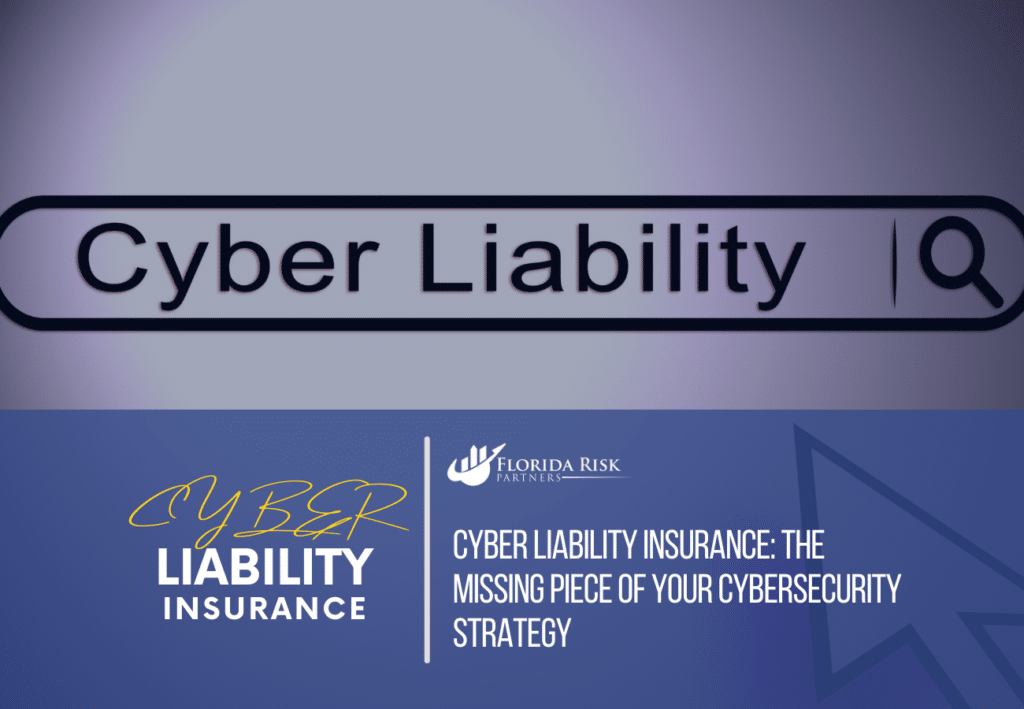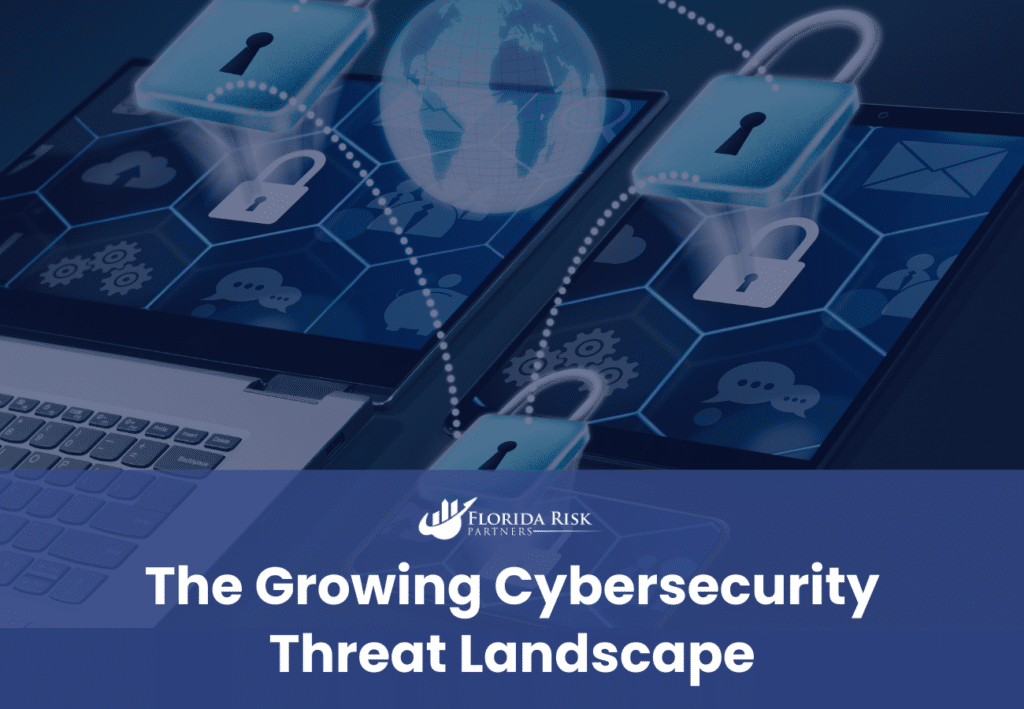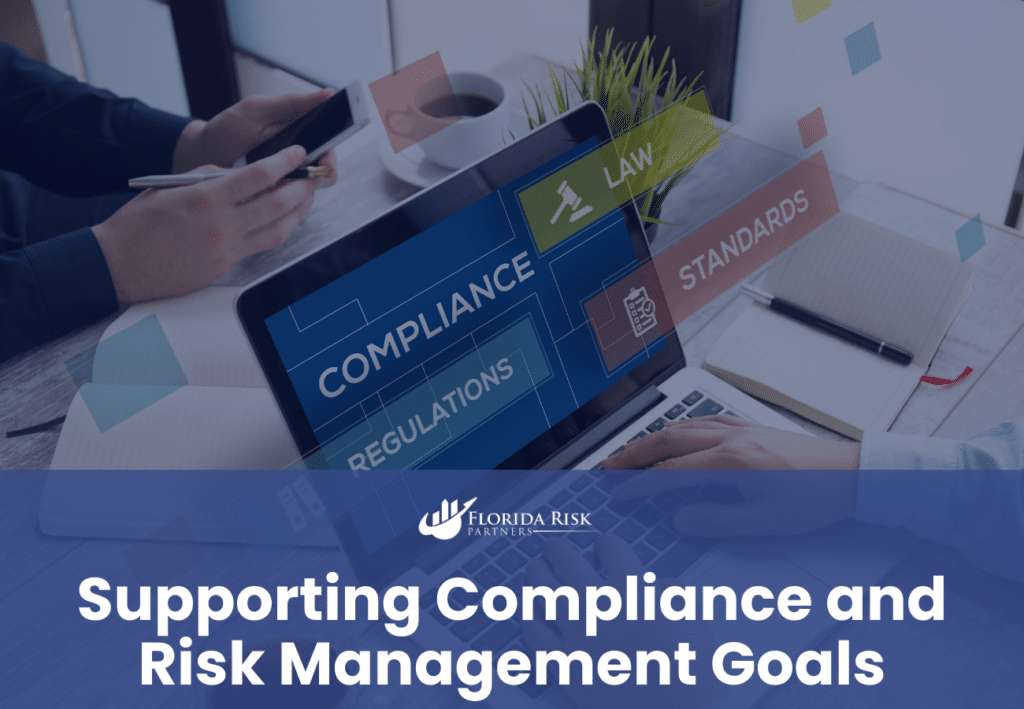-
Main Office: 1434 E. Bloomingdale Ave Valrico, FL 33596-6110
-
Phone: (888) 601-6660
-
Email: info@floridariskpartners.com

Businesses face a wide range of cyber threats that can disrupt operations, damage reputations, and lead to significant financial losses. While preventive measures like firewalls, antivirus software, and employee training are critical components of a cybersecurity program, they aren’t always enough. When cyberattacks occur—and statistics show they are increasingly inevitable—having a plan for recovery is just as important as prevention.
This is where cyber liability insurance comes in. It complements your existing cybersecurity efforts by providing financial protection and expert resources to help your business recover from a cyber incident. In this post, we’ll explore why cyber liability insurance is a vital part of your overall strategy and how it works in tandem with preventive measures to safeguard your business.
The Growing Cybersecurity Threat Landscape
Before diving into how cyber liability insurance fits into your strategy, it’s essential to understand the current state of cyber threats. Cyberattacks are no longer isolated events targeting large corporations; they are a widespread issue affecting businesses of all sizes and industries.
The Scope of Modern Cyber Threats
Cyber threats have evolved beyond traditional viruses and malware to include:
- Ransomware Attacks: Hackers encrypt your data and demand payment for its release.
- Phishing Scams: Fraudulent emails designed to trick employees into revealing sensitive information.
- Data Breaches: Unauthorized access to sensitive customer, employee, or business data.
- DDoS Attacks: Distributed Denial of Service attacks that overwhelm systems, causing operational downtime.
These threats can lead to:
- Financial losses from operational disruptions and data recovery efforts.
- Legal and regulatory fines due to compliance failures.
- Reputational damage, resulting in lost customers and reduced trust.
The Limitations of Preventive Cybersecurity Measures
While preventive measures are crucial, they have their limits:
- Human Error: Even the best-trained employees can fall victim to sophisticated phishing scams.
- Evolving Threats: Cybercriminals continuously develop new attack methods, making it difficult for preventive measures to keep up.
- Third-Party Risks: Vendors or partners with access to your systems can introduce vulnerabilities.
Preventive measures reduce the likelihood of a cyber incident but can’t eliminate the risk entirely. This is where cyber liability insurance provides critical support, stepping in to cover the financial and operational fallout of an attack.

How Cyber Liability Insurance Complements Your Cybersecurity Strategy
Cyber liability insurance is designed to work hand-in-hand with your cybersecurity program, addressing the gaps that preventive measures leave behind. Here’s how it enhances your overall strategy:
Financial Protection for Cyber Incidents
When a cyberattack occurs, the financial costs can be overwhelming. Cyber liability insurance provides coverage for a wide range of expenses, including:
- Data Breach Response Costs: Notifying affected customers, providing credit monitoring, and hiring forensic experts.
- Ransomware Payments: Paying ransom demands (where legally permitted) and recovering encrypted data.
- Business Interruption Losses: Compensating for revenue lost during system downtime.
- Legal and Regulatory Costs: Covering attorney fees, court costs, and regulatory fines.
Why This Matters:
Without insurance, these costs can cripple your business, especially if you’re a small or mid-sized company. Cyber liability insurance ensures you have the resources to recover.
Access to Incident Response Resources
Many cyber liability policies include access to specialized resources, such as:
- Forensic Experts: Professionals who investigate the cause and scope of the incident.
- Public Relations Specialists: Experts who manage communications to protect your reputation.
- Legal Counsel: Attorneys who ensure compliance with breach notification laws and regulatory requirements.
Why This Matters:
These resources enable a swift, coordinated response, minimizing the damage and downtime caused by a cyber incident.
Bridging Gaps in Traditional Insurance Policies
Traditional insurance policies, like general liability or property insurance, often exclude cyber risks. Cyber liability insurance fills these gaps by providing specialized coverage for digital threats.
Examples of Coverage Gaps:
- General Liability Insurance: Covers physical injuries and property damage, not data breaches or cyberattacks.
- Property Insurance: Protects tangible assets like buildings and equipment, not intangible assets like data.
- Errors and Omissions Insurance: Covers professional mistakes but excludes damages caused by cyber incidents.
Why This Matters:
Without cyber liability insurance, your business could be left vulnerable to significant financial risks that traditional policies don’t address.
Supporting Compliance and Risk Management Goals
Cyber liability insurance is particularly valuable for businesses subject to data protection regulations, such as:
- GDPR (General Data Protection Regulation) in the European Union.
- CCPA (California Consumer Privacy Act) in the United States.
- HIPAA (Health Insurance Portability and Accountability Act) for healthcare providers.
These regulations often require businesses to take specific actions after a data breach, such as notifying affected parties and implementing corrective measures. Cyber liability insurance can cover these costs and provide expert guidance to ensure compliance.
Why This Matters:
Non-compliance with data protection laws can result in hefty fines and legal consequences. Insurance helps you navigate these challenges with confidence.

Integrating Cyber Liability Insurance into Your Cybersecurity Strategy
To maximize the benefits of cyber liability insurance, it’s essential to integrate it seamlessly into your broader cybersecurity strategy. Here’s how to do it:
Align Coverage with Your Risks
Use a cyber risk assessment to identify your vulnerabilities and select a policy that addresses your specific needs. For example:
- If you handle sensitive customer data, prioritize coverage for breach response costs.
- If ransomware is a concern, ensure your policy includes robust ransomware coverage.
Incorporate Insurance into Your Incident Response Plan
Ensure your incident response plan includes steps for activating your cyber liability insurance policy, such as:
- Notifying your insurer promptly.
- Accessing breach response resources included in the policy.
- Documenting the incident to support your claim.
Review and Update Regularly
As your business evolves, so do your cyber risks. Review your policy annually to ensure it remains aligned with your operations and risk profile. Work with your broker to adjust coverage as needed.
The Bottom Line
While preventive cybersecurity measures are essential, they can’t eliminate the risk of a cyberattack entirely. Cyber liability insurance fills the gaps, providing financial protection and access to expert resources when a cyber incident occurs. Together, these tools create a comprehensive defense against the growing threat of cybercrime.
To learn more about how cyber liability insurance can enhance your cybersecurity strategy, explore our detailed guide: Enhancing Your Cybersecurity Program. This resource provides actionable insights to help you build a resilient and effective approach to cyber risk management.
Download Our Complimentary Guide to Purchasing Cyberliability Insurance
Don’t leave your business vulnerable to the unexpected—integrate cyber liability insurance into your strategy today.
Call Us Or
Schedule an Appointment
Select an agent below to view our online calendars and select a day and time that works best for you or call us directly at 888-601-6660. When you use our online calendars, you will receive an email with more information.



